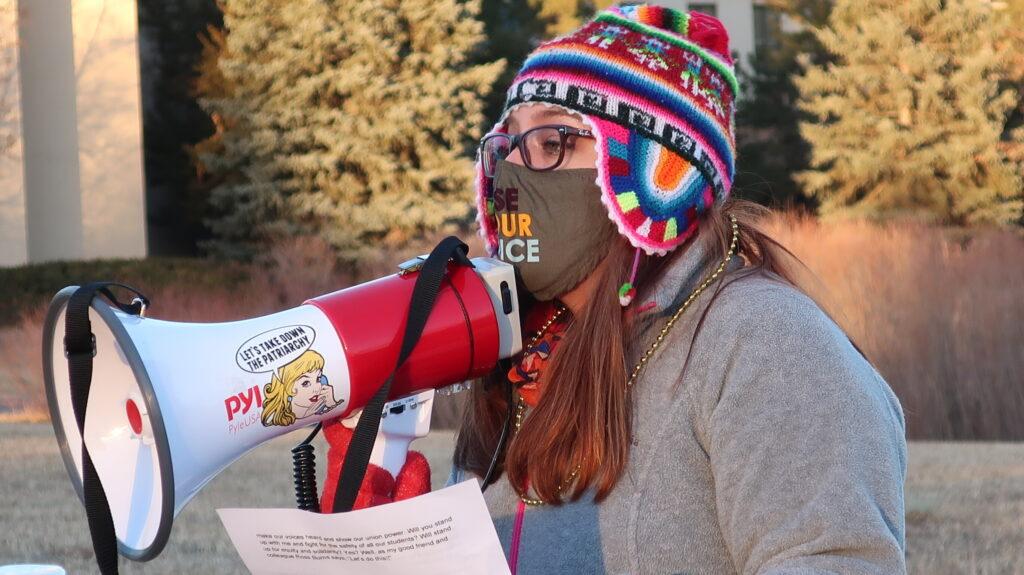Teachers in the Jefferson County School District said Wednesday that they are concerned about the district’s plan to educate elementary students in-person. The district plans to begin returning students to school buildings on Jan. 19 and will resume remote learning only if the district moves to the most severe level on Colorado’s COVID-19 dial framework.
“School health and safety is community health and safety,” said Brooke Williams, president of the Jefferson County Education Association, the Jeffco Schools teachers union. “Schools do not operate in a bubble.” Williams led a protest of several dozen teachers outside Jefferson County School District headquarters Wednesday.
The district returned to remote learning Jan. 6 and will implement a staggered in-person school reopening plan, with grades Kindergarten through fifth grade scheduled to return January 19 unless the county is in the purple level of extreme risk on the state’s COVID-19 status scale. A return to hybrid learning is being considered for February 1 for older students.
Jefferson County Public Health advised the district to follow a 14-day pause prior to opening schools for in-person instruction to avoid virus spread which could lead to immediate student and staff quarantines. Union leaders applauded the district for implementing the pause.
But some teachers say the 14 days is not long enough. Fourth grade teacher Laura Grims is concerned about the fallout from people she knows, both students and teachers, who traveled over the holidays “so to think that they’ll be back in classrooms in just over a week is really terrifying.”
“We know that our plan for January will not make everyone happy,” the district wrote in a December 18 letter to families. “Some want schools to return to 100 percent in-person learning immediately, others want us to wait even longer than our plan.”
The district says it met in December with hundreds of stakeholders on the plan including parents, students, teachers, support staff, and administrators to review the plan and gather feedback.
“We believe what we have put forward here is the most reasonable, safe, and sustainable way to get our students and staff back to in-person learning.”

But the union says its own December survey found the majority of teachers would only feel comfortable teaching in person when the county was in levels orange or yellow, when COVID-19 positivity rates are below 10 percent. Jefferson County is currently at an orange level.
“If we flatten that curve, we can be in-person longer, giving more sustainability to our students, meeting those mental health needs and those learning gaps, and not ping-ponging between in-person remote and hybrid,” Williams said. Teachers are concerned that if rates rise and the county moves to red, schools would remain open.
Only fifteen percent of teachers in the survey felt comfortable teaching in the red and purple levels.
Rotating between remote, in-person, and hybrid learning with little warning was and will continue to be difficult for parents, students and teachers who are juggling caregiving, work and home responsibilities, Williams said.
She said when the community reached 8 to 9 percent positivity rates, that’s when “the wheels started to fall off the bus” and it became impossible to sustain meaningful teaching with teachers and students in quarantine.
Parent Jill Yordy said the district’s current plan — for elementary students to stay in in-person learning unless the county is in a purple status level — leaves too much room for instability and leaves parents with too short notice that their children may have to learn remotely from home for two weeks.
“I don't think we should be pushing for in-person learning when we're not at least 90 percent confident that the plan we have in place will work successfully and allow students the greatest sense of stability that we can offer,” Yordy said.
She said she would like to see more robust data analysis to understand the relationship between community spread and staff capacity to operate schools.
The teachers’ union is also concerned about the district’s “operational capacity” plan, that is, a building would close if 10 percent of the staff are absent in elementary schools, 15 percent in middle schools, and 20 percent in high schools. Teachers on Wednesday said there is a greater chance that schools with high numbers of students of color and low-income students, where COVID-19 rates have been higher, would close.
“That creates inequities,” Williams said.
She said she is frustrated the state has not provided clear and consistent guidance on navigating the realities of the pandemic, leaving individual districts and schools struggling to make decisions.
“There is no place on earth we want to be than in our schools with our students, but we need to do that safely,” Williams said.









